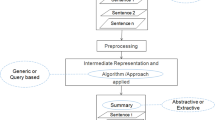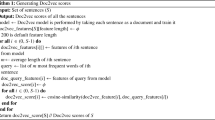Abstract
In Natural Language Processing, text summarization is one of the prominent applications in digital trend for extracting information from a single or multiple documents and making a summary of the document/documents. There has been an extensive study on extractive summarization process. Here, in the proposed model, topics are generated by using topic modelling techniques like LDA or HDP, Probabilities are generated after topics are classified with selected optimal number of topics, using the probabilities of the term for each topic the sentence probability is calculated using term probability and entropies are calculated for topic and sentence, Sentence scores are calculated by taking Sentence entropy in topic spaces of the topic which has highest entropy in term space and similarity score between the sentences. The top sentences that are having score which is more than threshold score those sentences are considered and if any duplicates are present in the list of sentences, those duplicates are removed, remaining sentences are joined to form a summary and evaluated against the target summary using ROUGE metrics. The LDA model achieved the accuracy of 75% as compared with state-of-the art methods by considering the WikiHow dataset.
Access this chapter
Tax calculation will be finalised at checkout
Purchases are for personal use only
Similar content being viewed by others
References
Ailem M, Zhang B, Sha F (2019) Topic augmented generator for abstractive summarization [online]. Available at http://arxiv.org/abs/1908.07026
Issam KAR, Patel S (2020) Topic modeling based extractive text summarization. Int J Innov Technol Explor Eng 96:1710–1719
Madhuri JN, Ganesh Kumar R (2019) Extractive text summarization using sentence ranking. In: 2019 international conference on data science and communication. IconDSC 2019, pp 3–5
Alami N, Meknassi M, En-nahnahi N, El Adlouni Y, Ammor O (2021) Unsupervised neural networks for automatic Arabic text summarization using document clustering and topic modeling. Expert Syst Appl 172:114652. Available at: https://doi.org/10.1016/j.eswa.2021.114652
Mohd M, Jan R, Shah M (2020) Text document summarization using word embedding. Expert Syst Appl 143:112958. Available at https://doi.org/10.1016/j.eswa.2019.112958
Srivastava R, Singh P, Rana KPS, Kumar V (2022) A topic modelled unsupervised approach to single document extractive text summarization. Knowl-Based Syst 246:108636. Available at https://doi.org/10.1016/j.knosys.2022.108636
Lamsiyah S, El Mahdaouy A, Espinasse B, El Alaoui Ouatik S (2021) An unsupervised method for extractive multi-document summarization based on centroid approach and sentence embeddings. Expert Syst Appl 167:114152. Available at https://doi.org/10.1016/j.eswa.2020.114152
Merchant K, Pande Y (2018) NLP based latent semantic analysis for legal text summarization. In: 2018 international conference on advances in computing, communications and informatics. ICACCI 2018, pp 1803–1807
Khurana A, Bhatnagar V (2022) Investigating entropy for extractive document summarization. Expert Syst Appl 187
Belwal RC, Rai S, Gupta A (2021) Text summarization using topic-based vector space model and semantic measure. Inf Process Manage 583:102536. https://doi.org/10.1016/j.ipm.2021.102536
Meena SM, Ramkumar MP, Asmitha RE, Emil Selvan GS (2020) Text summarization using text frequency ranking sentence prediction. In: 4th international conference on computer, communication and signal processing. ICCCSP 2020, pp 1–5
Desai MR, Gachhinakatti B, Balaganur P, Rajeshwari Y, Rathod L (2021) Automatic text summarization in natural language processing. In: 2021 IEEE international conference on mobile networks and wireless communications. ICM-NWC 2021, p 4
Zhong M, Liu P, Chen Y, Wang D, Qiu X, Huang X (2020) Extractive summarization as text matching, pp 6197–6208
Satyanarayana Murthy T et al (2022) Effective return rate prediction of blockchain financial products using machine learning. Comput Mater Continua 74(1):2303–2316
Satyanarayana Murthy T (2022) An efficient diabetic prediction system for better diagnosis. Int J Intell Enterprise: 408–421. https://doi.org/10.1504/IJIE.2022.126397
Satyanarayana Murthy, T, Gopalan NP, Athira TR (2020) Hiding critical transactions using modified un-realization approach. Int J Bus Intell 15(3):223–234. https://doi.org/10.1504/IJEB.2020.109071
Teki SM, Varma MK, Yadav AK (2021) A diabetic prediction system based on mean shift clustering. ISI, IIETA Publisher, vol 36, no 2, pp 231–235. https://doi.org/10.18280/isi.260210
Teki SM, Varma MK, Harsha (2021). Brain tumour segmentation using U-net based adversarial networks. Traitement du Signal, IIETA Publisher, vol 36, no 4, pp 353–359. https://doi.org/10.18280/ts.360408
Teki SM, Banothu B, Varma MK (2019) An un-realization algorithm for effective privacy preservation using classification and regression trees. Revue d’Intelligence Artificielle 33(4):313–319. https://doi.org/10.18280/ria.33040
Navaneetha Krishnan S, Sundara Vadivel P, Yuvaraj D, Satyanarayana Murthy T, Malla SJ et al (2022) Enhanced route optimization for wireless networks using meta-heuristic engineering. Comput Syst Sci Eng 43(1):17–26
Shanmuga Priya S, Yuvaraj D, Satyanarayana Murthy T, Chooralil VS, Navaneetha Krishnan S et al (2022) Secure key management based mobile authentication in cloud. Comput Syst Sci Eng 43(3):887–896
Teki SM, Varma MK, Roy S (2020) Improving the performance of association rules hiding using hybrid optimization algorithm. J Appl Secur Res 15(3):423–437. https://doi.org/10.1080/19361610.2020.1756155
Satyanarayana Murthy T, Gopalan NP, Yakobu D (2019) An efficient un-realization algorithm for privacy preserving decision tree learning using McDiarmid’s bound. Int J Innov Technol Exploring Eng (IJITEE) 8(4S2):499–502
Satyanarayana Murthy T, Gopalan NP, Gunturu S (2018) A novel optimization based algorithm to hide sensitive item-sets through sanitization approach. Int J Mod Educ Comput Sci (IJMECS) 10(10):48–55. https://doi.org/10.5815/ijmecs.2018.10.06
Satyanarayana Murthy T, Gopalan NP, Alla DSK (2018) The power of anonymization and sensitive knowledge hiding using sanitization approach. Int J Mod Educ Comput Sci (IJMECS) 10(9), 26–32. https://doi.org/10.5815/ijmecs.2018.09.04
Satyanarayana Murthy T, Gopalan NP (2018) A novel algorithm for association rule hiding. Int J Inf Eng Electron Bus (IJIEEB) 10(3):45–50. https://doi.org/10.5815/ijieeb.2018.03.06
SaiBabu A, Murthy TSN (2012) Security provision in publicly auditable secure cloud data storage services using SHA-1 algorithm. Int J Comput Sci Inf Technol 3(3):4084–4088
Sathyanarayana Murthy T, Mohan Krishna Varma N, Ravuri D, Kishore Babu D, Nazeer S (2022) Classification of precious and non-precious tweets using deep learning. In: Rout RR, Ghosh SK, Jana PK, Tripathy AK, Sahoo JP, Li KC (eds) Advances in distributed computing and machine learning. Lecture notes in networks and systems, vol 427. Springer, Singapore. https://doi.org/10.1007/978-981-19-1018-033
Satyanarayana Murthy T, Mohan Krishna Varma N, Roy S, Nazeer S (2022) Effective classification of tweets using machine learning. In: Kumar R, Ahn CW, Sharma TK, Verma OP, Agarwal A (eds) Soft computing: theories and applications. Lecture notes in networks and systems, vol 425. Springer, Singapore. https://doi.org/10.1007/978-981-19-0707-440
Murthy TS, Gopalan NP, Ramachandran V (2019) A Naive Bayes classifier for detecting unusual customer consumption profiles in power distribution systems—APSPDCL. In: 2019 third international conference on inventive systems and control (ICISC). JCT College, Coimbatore, India, pp 673–678
Satyanarayana Murthy T, Preethi G, Gopalan NP (2018) An efficient way of anonymization without subjecting to attacks using secure matrix method. In: Proceedings of the IEEE international conference on intelligent computing and control systems. Vaigai College of Engineering, Madurai, June 2018, pp 1462–1465
Satyanarayana Murthy T, Gopalan NP (2018) An efficient meta-heuristic chemical reaction based algorithm for association rule hiding using an advanced perturbation approach. In: Proceedings of the IEEE international conference on intelligent computing and control systems. Vaigai College of Engineering, Madurai, June 2018. IEEE
Gopalan NP, Satyanarayana Murthy T (2017) Association rule hiding using chemical reaction optimization. Presented a paper at 7th international conference on soft computing for problem solving—SocProS 2017, 23–24 Dec 2017, IIT Bhubaneswar, Orissa
Neelima G, Veeramanickam MRM, Gorbachev S, Kale SA (2019) Extractive text summarization using deep natural language fuzzy processing. Int J Innov Technol Explor Eng 86(4):990–993
Author information
Authors and Affiliations
Corresponding author
Editor information
Editors and Affiliations
Rights and permissions
Copyright information
© 2023 The Author(s), under exclusive license to Springer Nature Singapore Pte Ltd.
About this paper
Cite this paper
Vakkalagaddda, S., Satyanarayana Murthy, T. (2023). Extractive Text Summarization Using Topic Modelling and Entropy. In: Kumar, A., Ghinea, G., Merugu, S. (eds) Proceedings of the 2nd International Conference on Cognitive and Intelligent Computing. ICCIC 2022. Cognitive Science and Technology. Springer, Singapore. https://doi.org/10.1007/978-981-99-2746-3_35
Download citation
DOI: https://doi.org/10.1007/978-981-99-2746-3_35
Published:
Publisher Name: Springer, Singapore
Print ISBN: 978-981-99-2745-6
Online ISBN: 978-981-99-2746-3
eBook Packages: Intelligent Technologies and RoboticsIntelligent Technologies and Robotics (R0)




